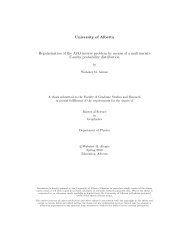Soner Bekleric Title of Thesis: Nonlinear Prediction via Volterra Ser
Soner Bekleric Title of Thesis: Nonlinear Prediction via Volterra Ser
Soner Bekleric Title of Thesis: Nonlinear Prediction via Volterra Ser
You also want an ePaper? Increase the reach of your titles
YUMPU automatically turns print PDFs into web optimized ePapers that Google loves.
3.2. NONLINEAR MODELING OF TIME SERIES 37<br />
Symmetry arguments in equations (3.19, 3.20 and 3.21) are also valid for the back-<br />
ward prediction. The number <strong>of</strong> coefficients for the cubic part is reduced from r 3<br />
to r 2 + r!/(r − 3)!3! and the total number <strong>of</strong> prediction coefficients is reduced form<br />
p + q 2 + r 3 to p + (q (q + 3)/2 − q) + r 2 + r!/(r − 3)!3!.<br />
and<br />
The form <strong>of</strong> the forward and backward prediction equations is now given by:<br />
x f n = a f<br />
1xn−1 + a f<br />
2xn−2 · · · + a f pxn−p<br />
+ b f<br />
11x 2 n−1 + 2b f<br />
12xn−1xn−2 + 2b f<br />
13xn−1xn−3 + · · · + b f qqx 2 n−q<br />
+ c f<br />
111x 3 n−1 + 3c f<br />
112x 2 n−1xn−2 + · · · + 6c f<br />
123xn−1xn−2xn−3 + · · · + c f rrrx 3 n−r<br />
+ εn , (3.22)<br />
x b n = a b 1xn+1 + a b 2xn+2 · · · + a b pxn+p<br />
+ b b 11x 2 n+1 + 2b b 12xn+1xn+2 + 2b b 31xn+1xn+3 + · · · + b b qqx 2 n+q<br />
+ c b 111x 3 n+1 + 3c b 112x 2 n+1xn+2 + · · · + 6c b 123xn+1xn+2xn+3 + · · · + c b rrrx 3 n+r<br />
+ εn . (3.23)<br />
As in the linear prediction problem, I will assume that the <strong>Volterra</strong> coefficients<br />
(linear, quadratic, and cubic) are obtained using actual observations. For example,<br />
assume p = 1, q = 2, c = 3, and a time series <strong>of</strong> N = 7 points:









